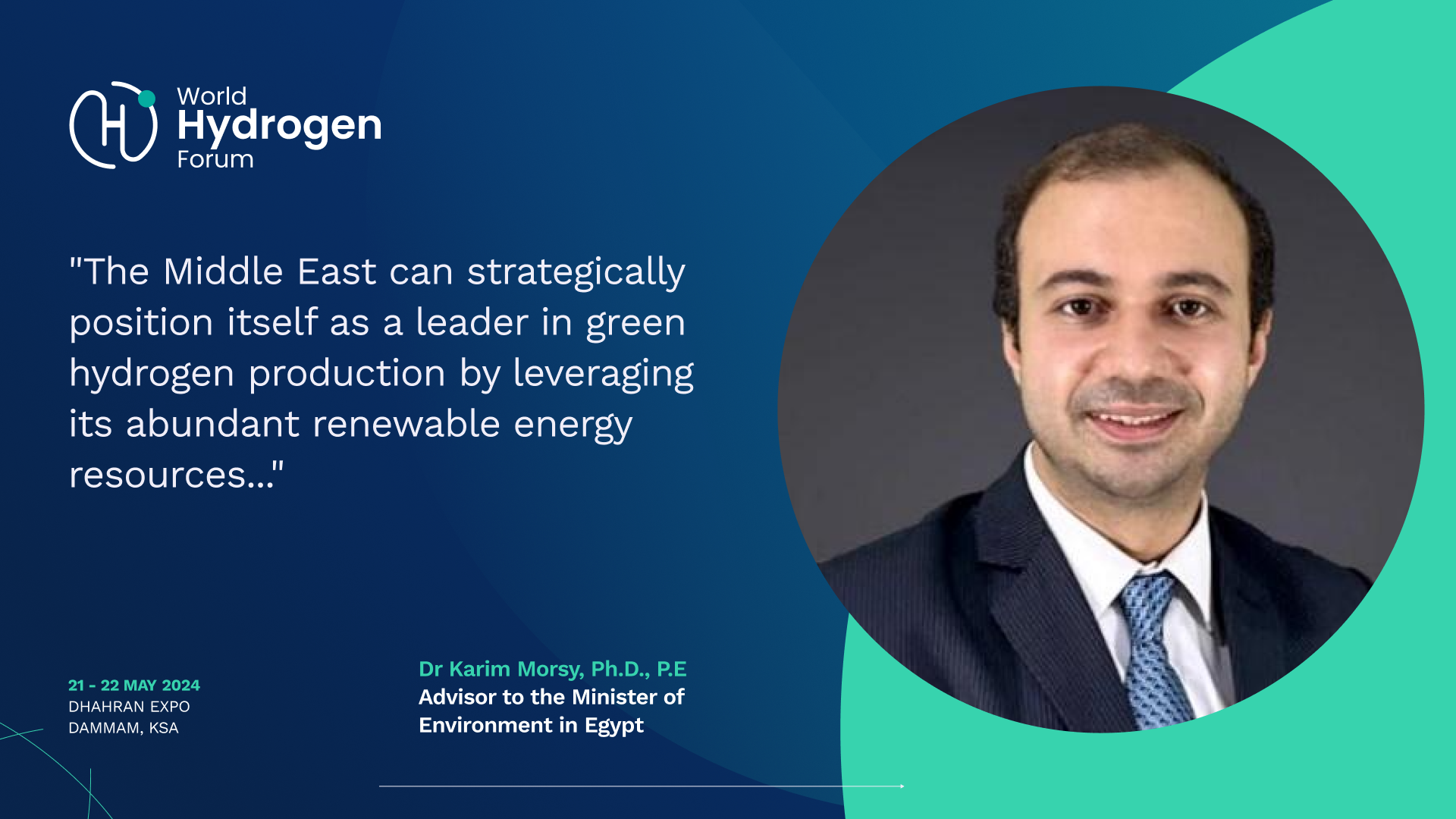We are delighted to present this Q&A session with Dr Karim Morsy, Ph.D., P.E., a leading expert in climate change and sustainability. As a licensed Professional Engineer, Advisor to the Minister of Environment in Egypt, and a recognized researcher, Dr Morsy brings a wealth of technical, academic, and policy experience to the table. In this session, he'll share his insights on the immense potential of green hydrogen for the Middle East's energy transition and its role in addressing global climate goals. We can expect Dr Morsy to offer valuable perspectives on emission reductions, innovative financing models, and the Middle East's strategic positioning as a potential leader in green hydrogen production.
#WHF: How can large-scale adoption of hydrogen, particularly green hydrogen, contribute to achieving emission reduction goals within the power and transportation sectors in the Middle East?
Dr Morsy: The large-scale adoption of hydrogen, especially green hydrogen, holds immense potential for the Middle East in achieving its emission reduction goals. In the power sector, green hydrogen offers a versatile solution for integrating renewable energy sources by serving as a means of energy storage and grid balancing. By utilizing green hydrogen for electricity generation, particularly in energy-intensive industries like desalination, the Middle East can reduce its reliance on fossil fuels and curb greenhouse gas emissions significantly. Additionally, in the transportation sector, green hydrogen can power fuel cell electric vehicles, providing a zero-emission alternative to conventional fossil fuels. Embracing hydrogen technologies across both power generation and transportation sectors presents a holistic approach towards achieving sustainability targets in the region.
#WHF: What innovative financial models can be implemented to facilitate investment in green hydrogen production and infrastructure in the Middle East?
Dr Morsy: To facilitate investment in green hydrogen production and infrastructure in the Middle East, innovative financial models are essential. One such model is the establishment of public-private partnerships, where governments collaborate with private entities to develop and finance hydrogen projects. Additionally, the issuance of green bonds dedicated to funding renewable energy and hydrogen initiatives can attract investment from environmentally conscious investors. Leveraging carbon pricing mechanisms can also provide economic incentives for investment in green hydrogen by internalizing the costs of carbon emissions. Moreover, creating dedicated investment funds focused on renewable energy and hydrogen projects can mobilize capital towards sustainable infrastructure development in the region.
#WHF: How can the Middle East strategically position itself to become a leader in green hydrogen production in the next decade and potentially an exporter to Europe and other regions?
Dr Morsy: The Middle East can strategically position itself as a leader in green hydrogen production by leveraging its abundant renewable energy resources and investing in scalable hydrogen production technologies. By capitalizing on its vast solar and wind potential, the region can produce green hydrogen at a competitive cost, making it an attractive supplier for international markets. Establishing strategic partnerships with European countries, which have ambitious decarbonization targets and a growing demand for green hydrogen, can create export opportunities for Middle Eastern producers. Additionally, investing in research and development to enhance the efficiency and cost-effectiveness of hydrogen production processes will be crucial for maintaining a competitive edge in the global hydrogen market.
#WHF: What key government policies and incentives would be most effective in driving the growth of the green hydrogen sector in the Middle East?
Dr Morsy: To drive the growth of the green hydrogen sector in the Middle East, governments can implement a range of policies and incentives. Firstly, setting ambitious renewable energy targets and mandates can incentivize the production of green hydrogen by ensuring a reliable supply of renewable electricity. Subsidies and low-interest loans can support the development of green hydrogen infrastructure, including electrolysis facilities and hydrogen refueling stations. Regulatory frameworks that promote the integration of green hydrogen into existing energy systems and transportation networks, such as fuel quality standards and infrastructure, can also stimulate market demand.
WHF: How do global events like the World Hydrogen Forum effectively accelerate progress on climate goals?
Dr Morsy: Global events like the World Hydrogen Forum play a crucial role in accelerating progress towards climate goals by fostering international collaboration and knowledge sharing on hydrogen technologies and initiatives. These events bring together policymakers, industry leaders, and experts from around the world to exchange ideas, share best practices, and identify opportunities for collaboration. By facilitating dialogue and networking among stakeholders, such forums can catalyze the development and deployment of hydrogen solutions on a global scale. Additionally, they raise awareness about the potential of hydrogen as a clean energy carrier and highlight the role it can play in decarbonizing various sectors of the economy. Through collaborative efforts and shared learning, global events like the World Hydrogen Forum contribute to building momentum for collective action towards achieving climate objectives.

